
The Bottom Line
Introduction, Specifications, and Pricing

BIOSTAR has increased their game when it comes to their high-end gaming motherboards, especially over the past few generations. Their Z170GT7 was one of my favorite motherboards because of its awesome heat sink RGB LEDs that let you choose motherboard color. No company until then had designed RGB LED heat sinks like that, and no company has really matched it since.
BIOSTAR has made improvements all around, from their software to their hardware and even UEFI, to become a more appealing gaming motherboard brand. They have a lot of competition when it comes to the market, and especially in this price bracket.
Let's see what their latest Z270GT6 has to offer.
Specifications

The Z270GT6 offers an Intel NIC, six SATA6Gb/s, M.2, U.2, RGB LED headers, and even overclocking features.
Pricing
The Z270GT6 costs $189.99.
Packaging and Z270GT6 Overview
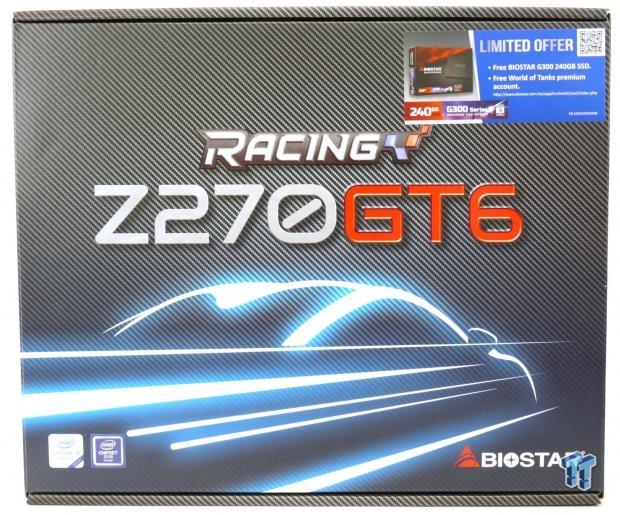
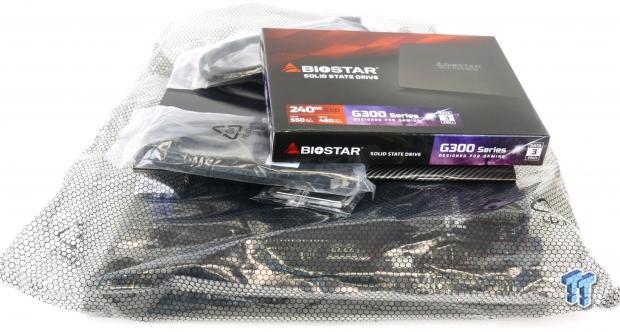
BIOSTAR's racing theme is still in full swing, and the Z270GT6 plays right into the theme. On the box is also BIOSTAR's free 240GB SSD promotion. Packaging is decent; the motherboard should arrive unharmed.
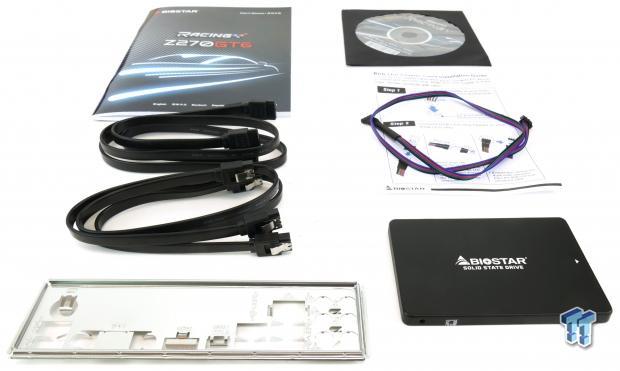
The accessory package includes four SATA6Gb/s cables, an IO shield, RGB LED extension cable, a 240GB SSD, driver DVD, and manual.
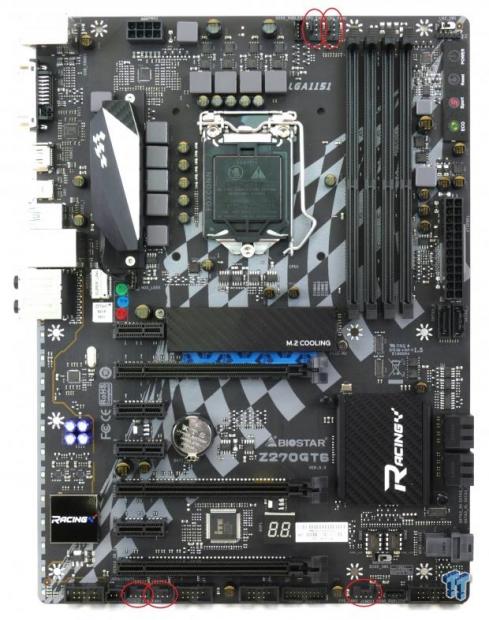
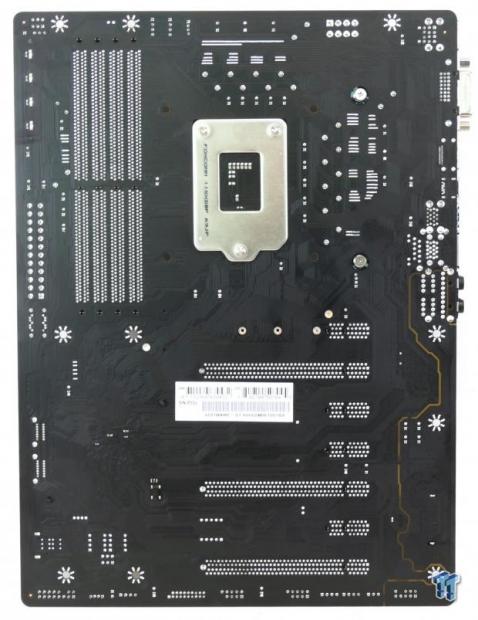
BIOSTAR's Z270GT6 has five fan headers circled in red, and they are all PWM mode headers. That means if you plug in a 3-pin DC mode fan, it will run at full speed. That is because 3-pin DC mode fans need the motherboard to regulate the voltage on the second pin, while PWM mode fans take in 12v and then regulate speed themselves based on the 4th pin on the header which sends a PWM signal to the fan.
The motherboard's aesthetics are not that bad. While I am not a fan of the racing flag silk screen, I do like the fact that the motherboard is mostly black. If you are worried about the silk screen, do not be. It will fade into the background in a case. The rear of the motherboard is bare of any major components; just some larger solder strips are present to help with VRM cooling.

The rear IO panel features PS/2 keyboard, two USB 2.0 ports, four USB 3.0 ports, USB 3.0 type-C, HDMI, DVI, Gbit LAN, and gold plated audio outputs.
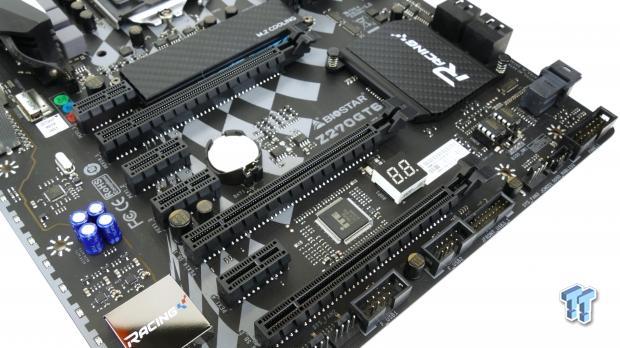
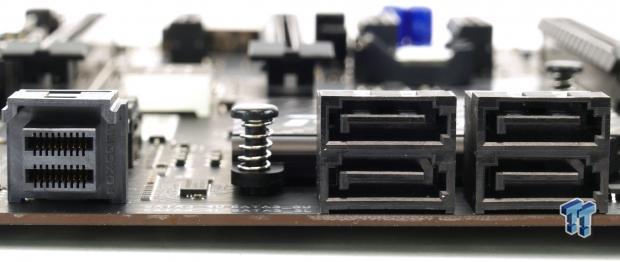
The PCI-E layout on this motherboard is not what you might think. The first x16 slot is wired x16 to the CPU. The second and third x16 slots are wired x4 to the PCH. They can be used for PCI-E based storage devices and support RST. The M.2 slot also shares bandwidth with the first slot. The U.2 connector shares bandwidth with SATA4_4U/4L. There are six SATA6Gb/s ports, four of them are at a 90-degree angle.
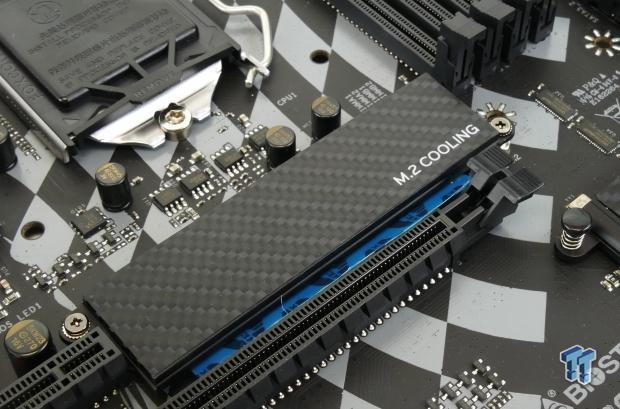
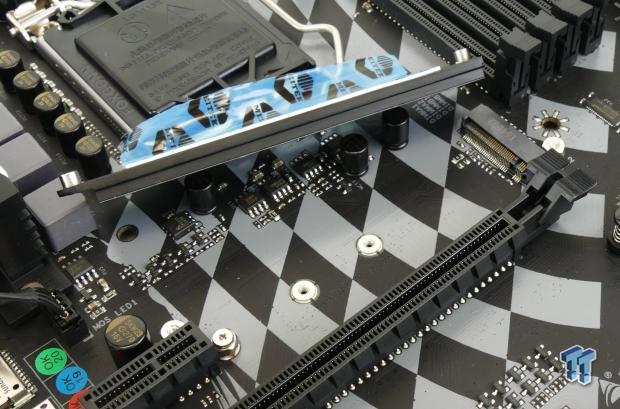
The M.2 slot has its own heat sink, and it is not a very thin piece of metal. It has a nice heat pad and actually has some fins integrated into it. It is one of the better M.2 heat sinks I have seen recently.
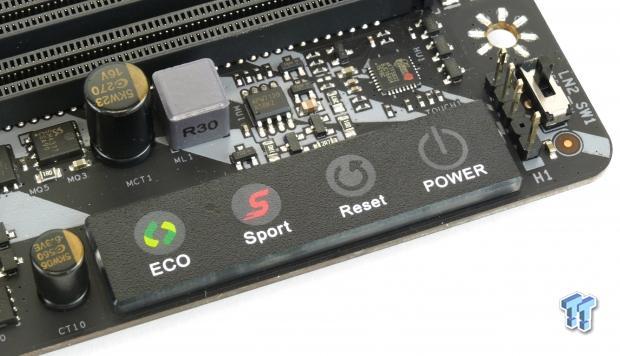
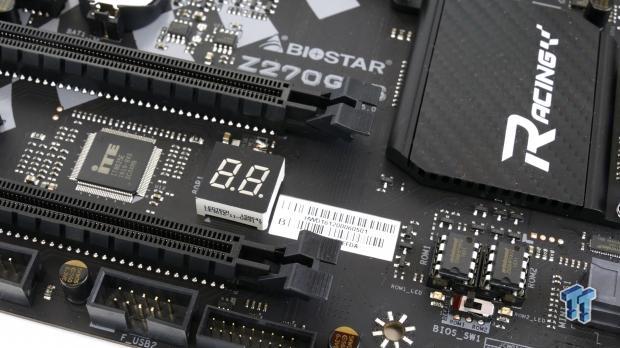
At the top of the motherboard is a touch pad sensor, which offers power, reset, ECO, and Sport buttons. An LN2 switch is located in the upper right-hand corner; it will shift CPU frequency to 800MHz on-the-fly when engaged. There is also a POST code display in between the second and third PCI-E x16 slots.
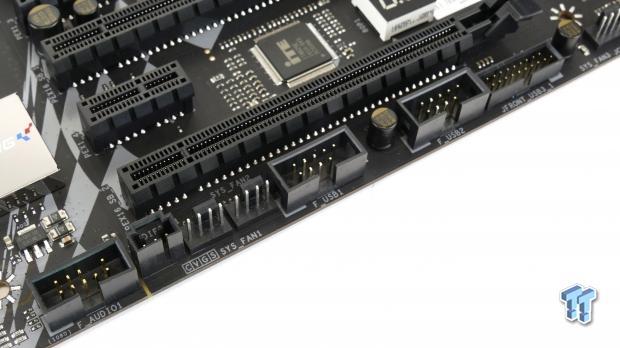
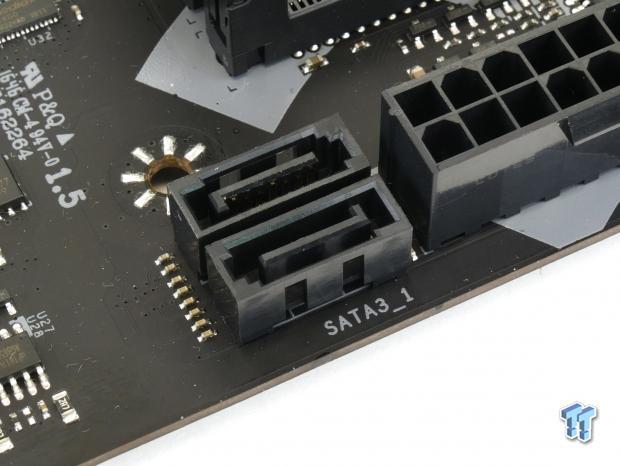
The bottom row of the motherboard features two USB 2.0 headers, a USB 3.0 header, and an audio header. Two of the six SATA6Gb/s ports are angled straight up, and they are located below the 24-pin power connector.
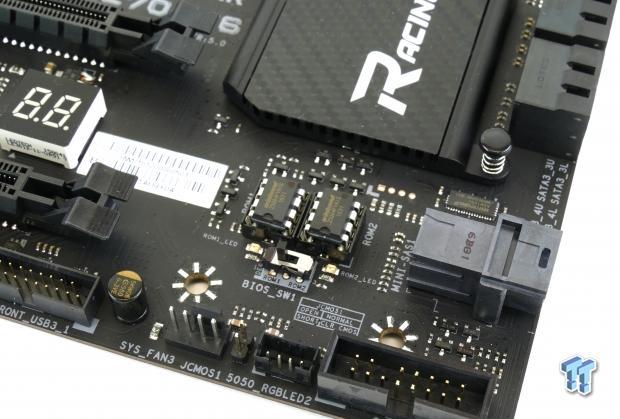
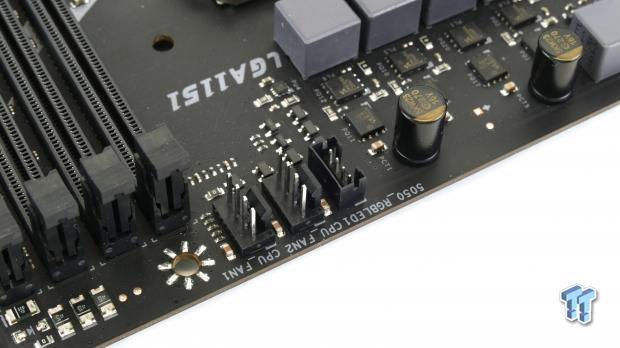
Two DIP sockets hold the 64Mbit BIOS ROMs, and there is a physical switch to choose which to use. There are two 5050 RGB LED headers on the motherboard; one right near the front panel headers and another near the CPU fan header.
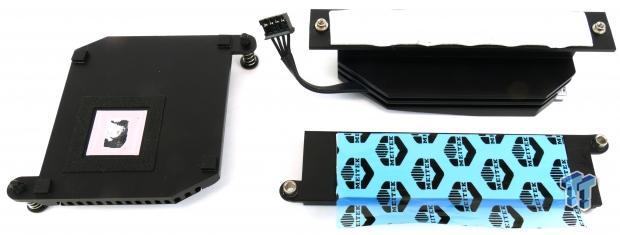
The PCH heat sink uses push pins while the VRM heat sink uses screws.
BIOSTAR Z270GT6 Circuit Analysis
Circuit Analysis
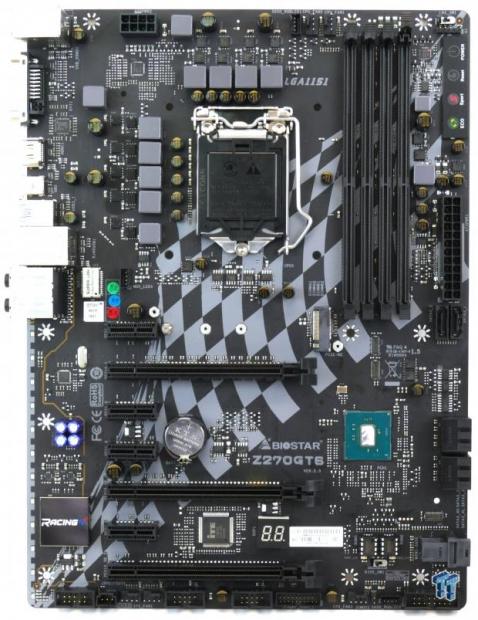
The Z270GT6 shows off its hardware when the heat sinks come off.
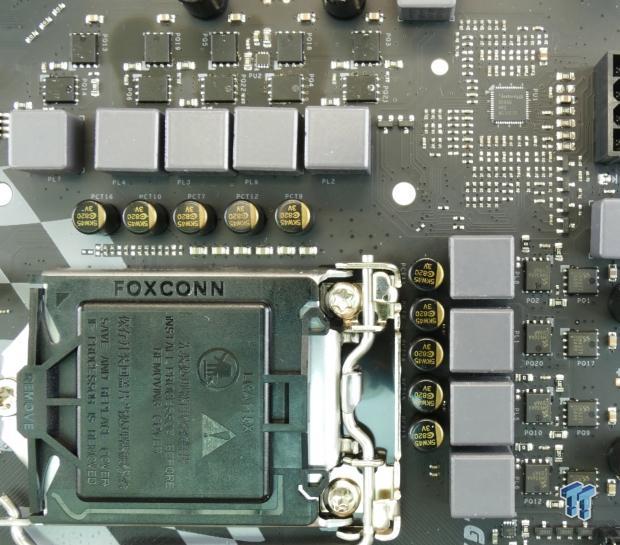
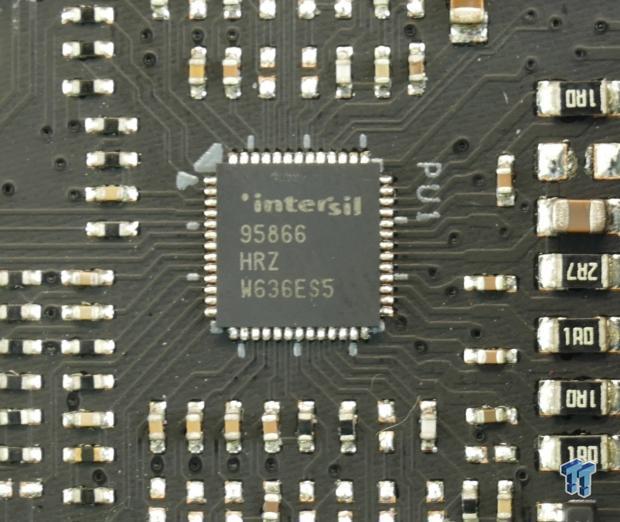
The motherboard's VRM is in a 6+2 phase configuration for the CPU+iGPU. The main PWM, an Intersil ISL95866 offers 4+3 phase output, but only 3+2 are being used. The PWM has two integrated drivers for the first rail and one for the second, so BIOSTAR supplements those with ISL6625A drivers.
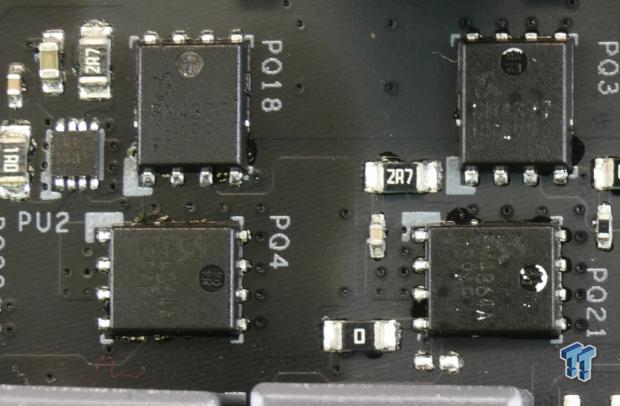
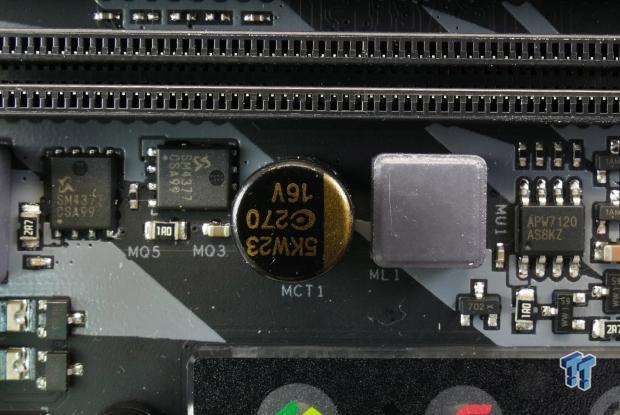
The MOSFETs are Sinopower SM4364 and SM4377 for the high-side and low-side MOSFETs. Doubling from three to six phases for the CPU is done by doubling the number of power stage components on each driver.
The memory VRM uses an Anpec APW7120 single-phase PWM controller with integrated driver, and the power stages are the same SM4377 we saw used in the CPU VRM.
BIOSTAR Z270GT6 Circuit Analysis Continued
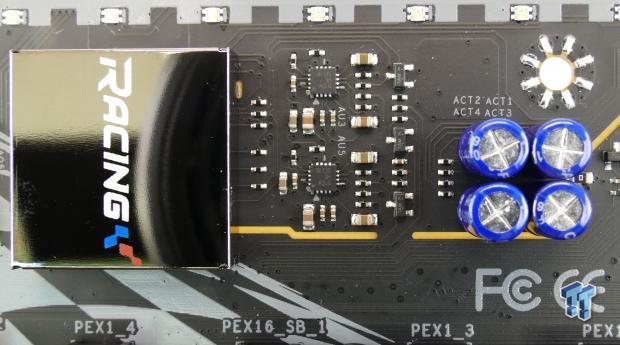
BIOSTAR is using the Realtek ALC892 audio codec along with two amplifiers in what BIOSTAR calls Double Hi-Fi. Both the rear and front audio headphone outputs are amplified. They are also using electrolytic audio capacitors, PCB division, and an EMI over the audio codec to help improve audio quality.
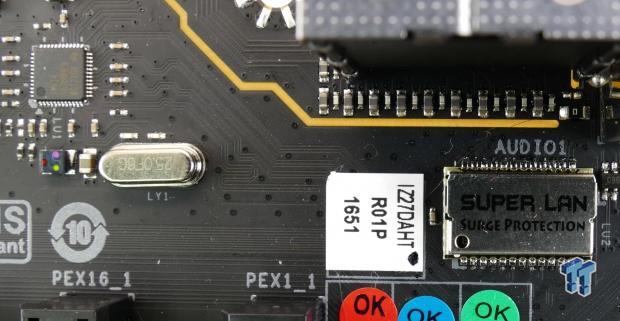
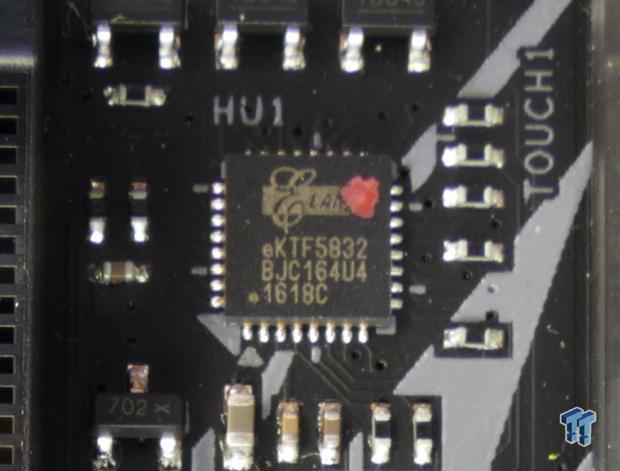
The single Gbit LAN port is through an Intel i219v PHY that works with the integrated MAC in the PCH. A Super LAN Surge Protection device is used to help protect from ESD. AN Elan eKTF5832 microprocessor with touch control is used to control the GT panel, and I also believe RGB LED functionality.

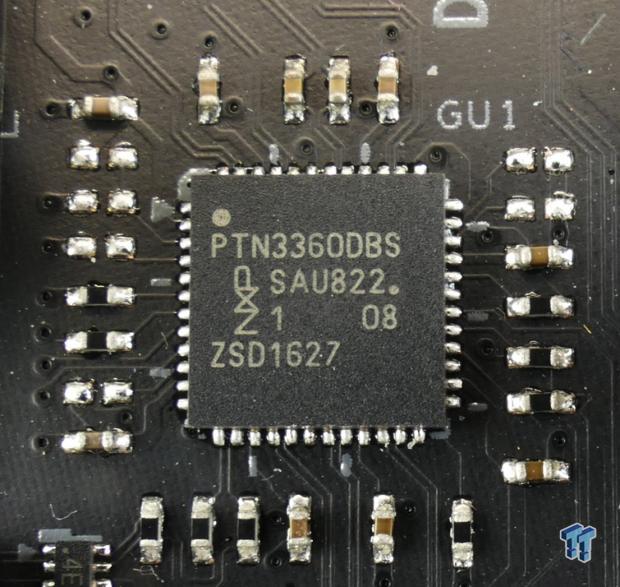
Two Winbond 64Mbit (8MB) BIOS ROMs hold copies of the BIOS, and you can switch between them with the physical switch. An NXP level shifter provides HDMI/DVI from the digital display output from the iGPU.
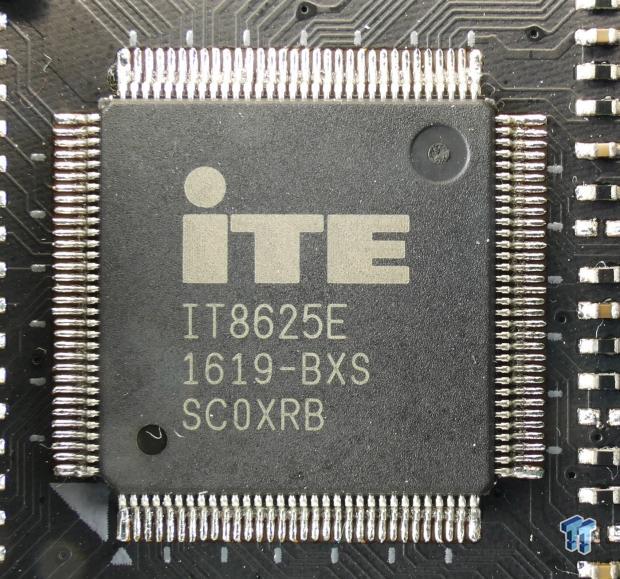
The iTE IT8625E is the main SuperIO that provides fan control, system monitoring, and even the PS/2 on the backpanel.
BIOS and Software
BIOS
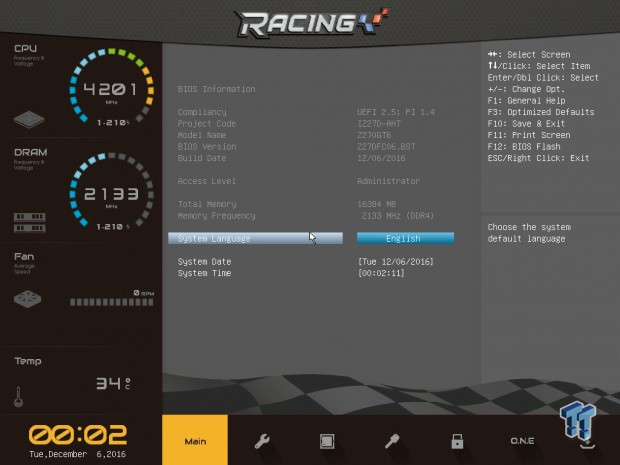
BIOSTAR's UEFI for the Z270GT6 is similar to that of their Z170GT7; it's newer than their previous BIOS, has more options, and is overall much better at overclocking. I had no problem tuning in my overclocks and no problem finding the right settings to get all the storage devices detected and in their proper boot order.
Overall, their UEFI is much better than in the past, and it is usable. It's also one of the only UEFIs with RGB LED control.
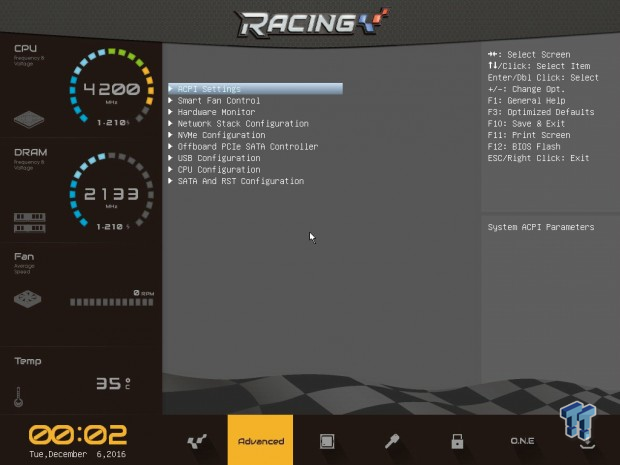
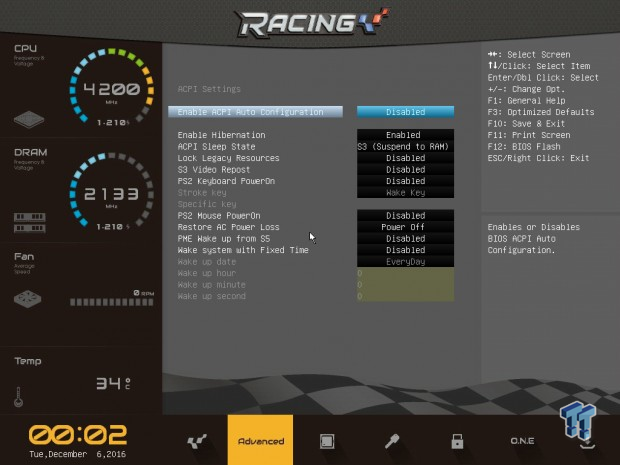
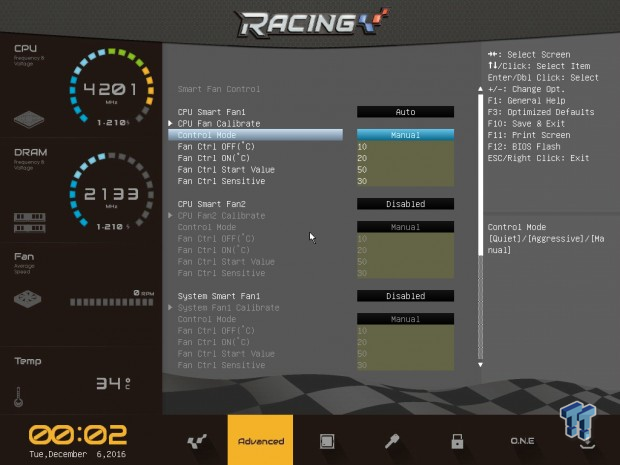
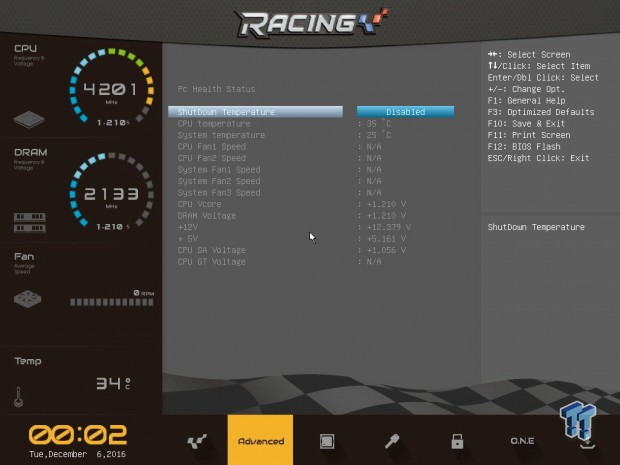
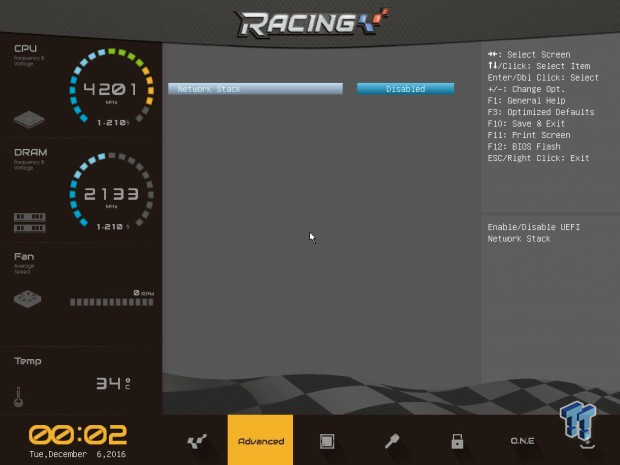
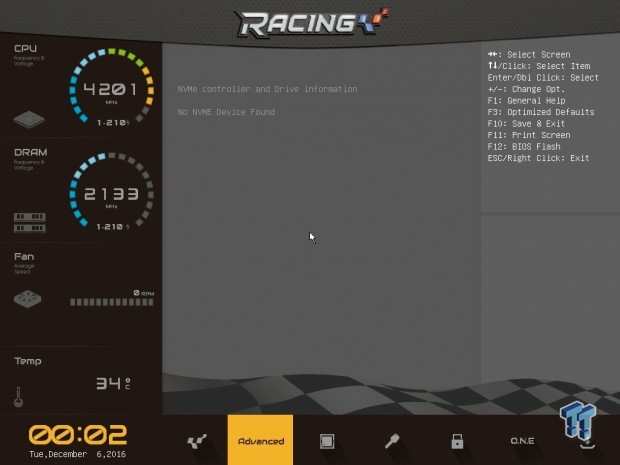
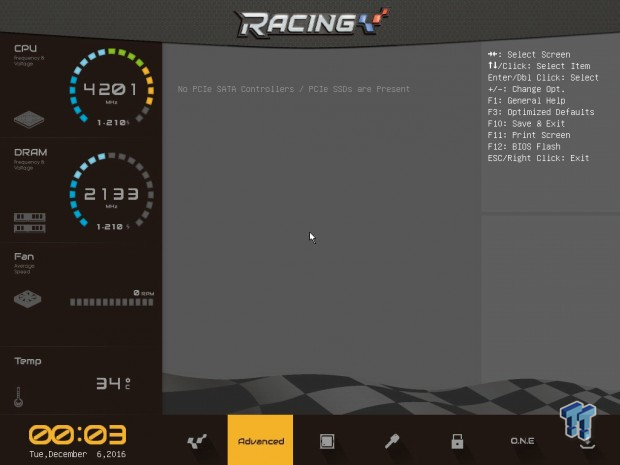
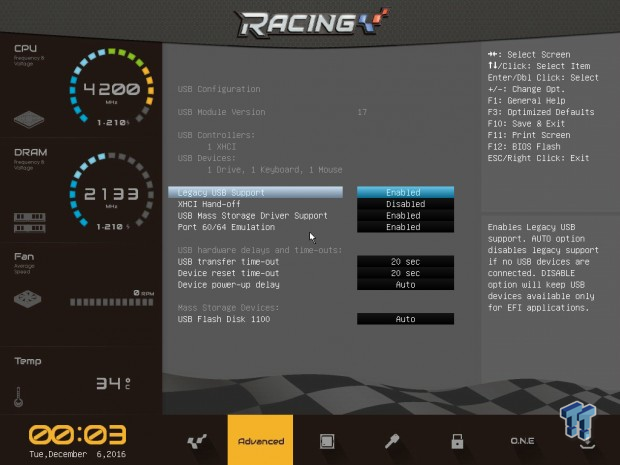
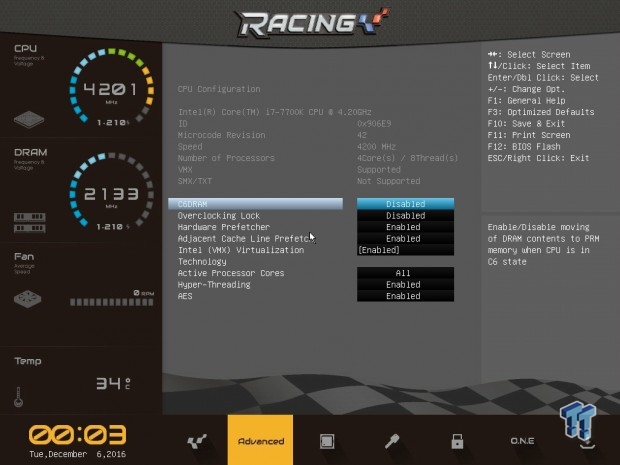
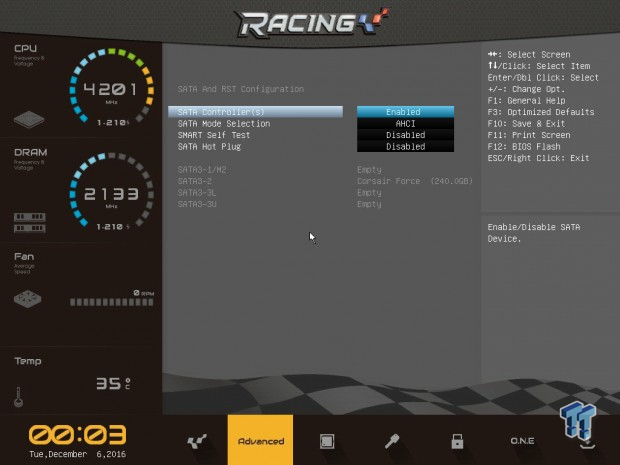
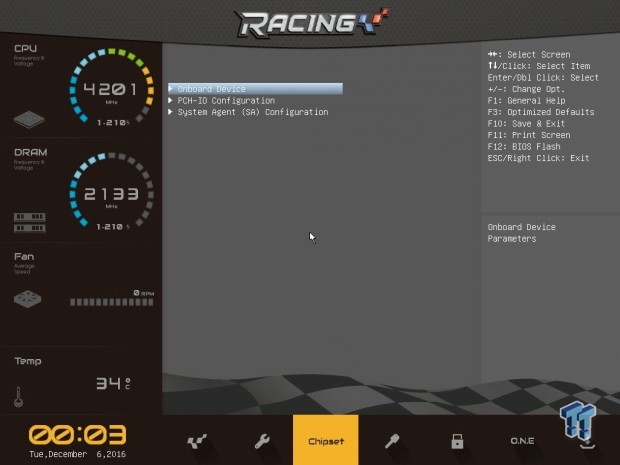
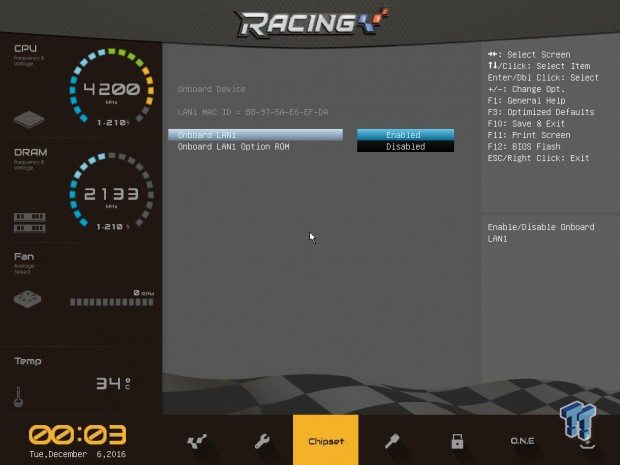
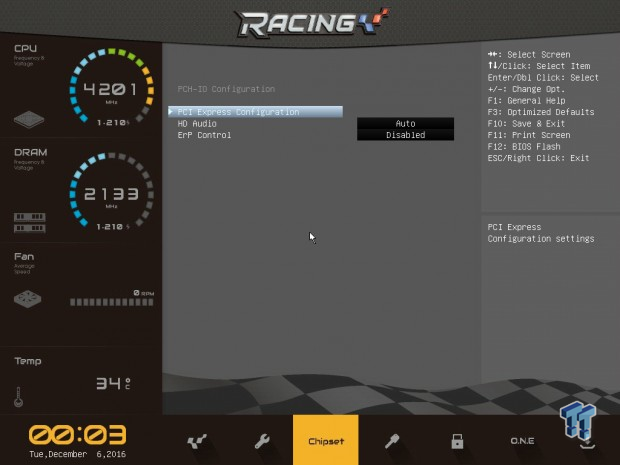
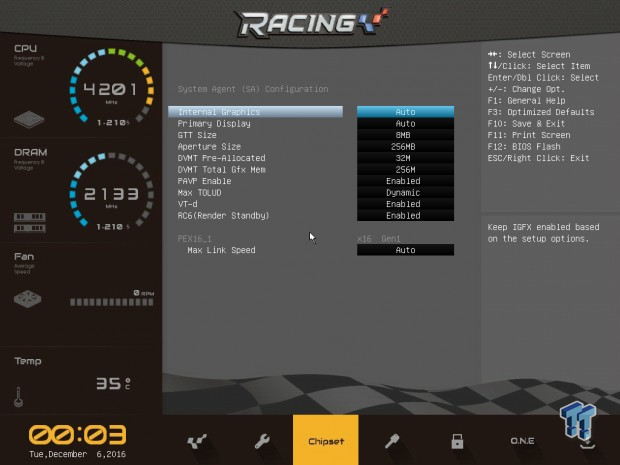
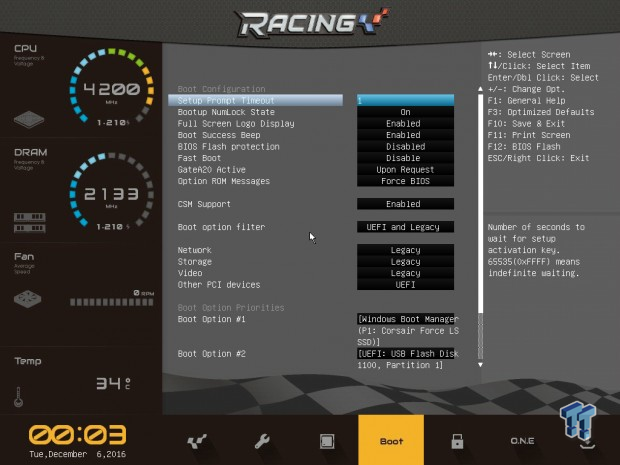
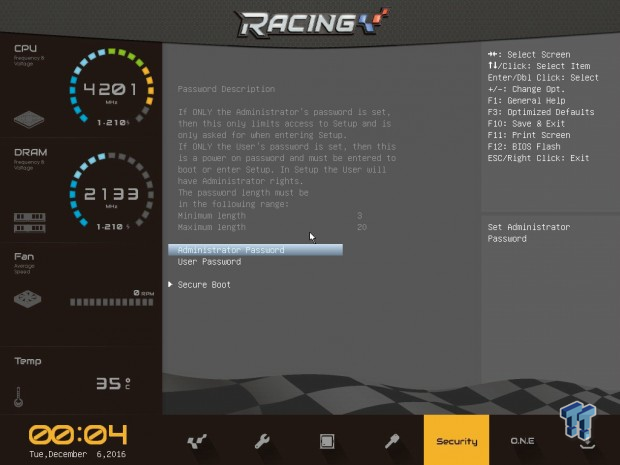
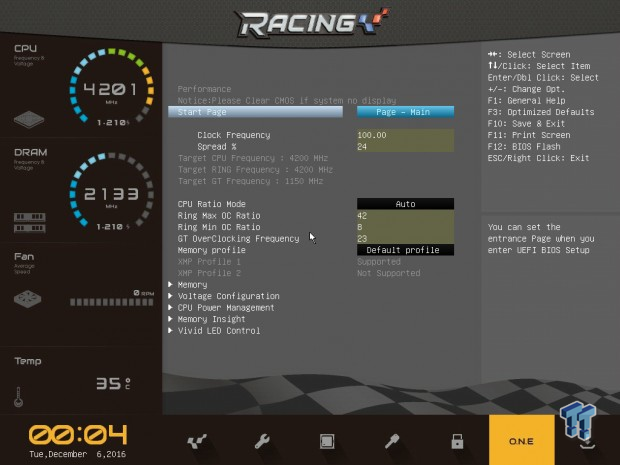
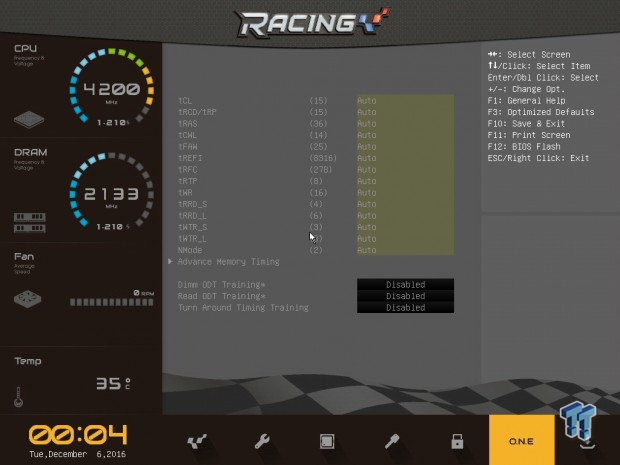
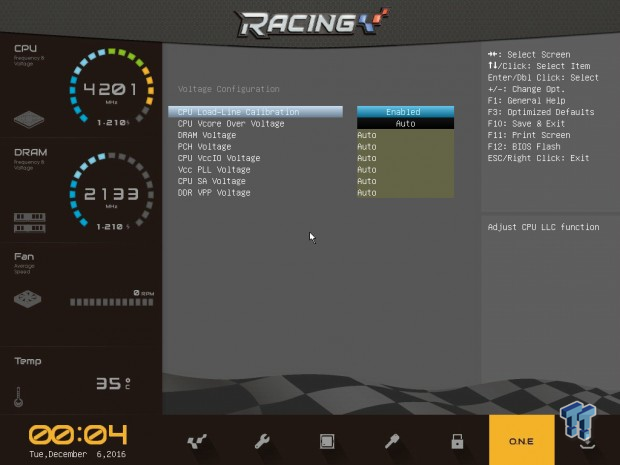
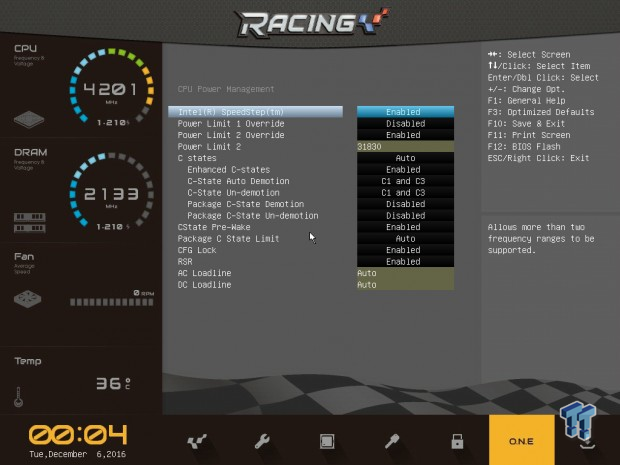
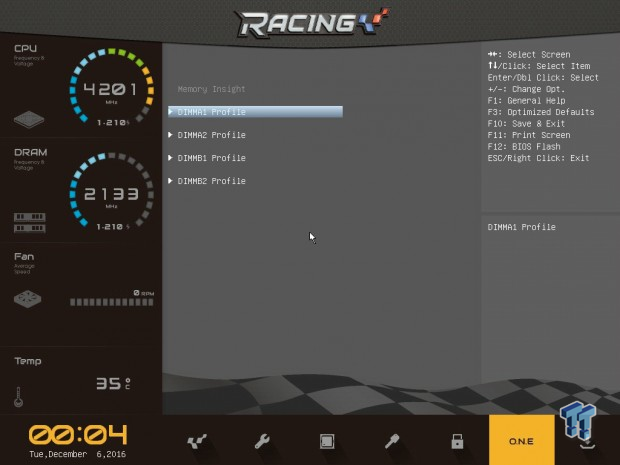
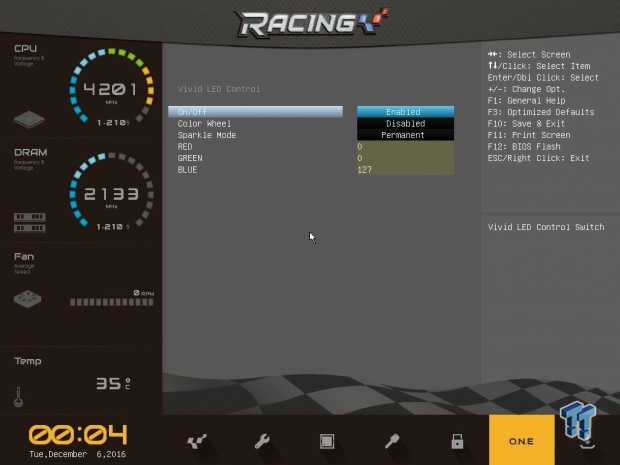
Software
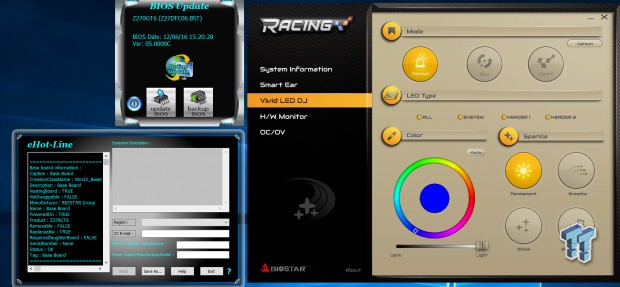
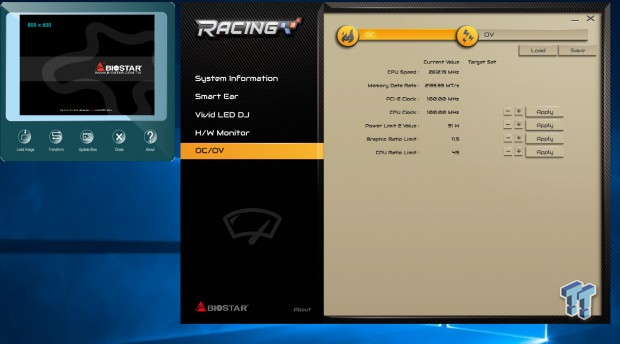
BIOSTAR's motherboard comes with a few software programs. They include BIOS Update, eHot-Line, Racing, and BIOS Screen. The Racing program allows you to do everything from Windows based overclocking to controlling the RGB LEDs and software based audio effects.
Test System Setup
Steven's Motherboard Test System Specifications
- Motherboard: BIOSTAR Z270GT6
- CPU: Intel Core i7 7700K
- Cooler: Corsair H115i GT - Buy from Amazon
- Memory: Corsair Dominator Platinum (2x8GB) 3200MHz
- Video Card: NVIDIA GeForce GTX 980 - Buy from Amazon / Read our review
- Storage - Boot Drive: Samsung 950 Pro 256GB - Buy from Amazon / Read our review
- Storage - SATA6G Drive: Corsair Force LS 240GB - Buy from Amazon / Read our review
- Storage - M.2 Drive: Intel 750 400GB U.2
- Storage - USB Drive: Corsair Voyager GS 64GB - Buy from Amazon / Read our review
- Case: Corsair Obsidian 900D - Buy from Amazon / Read our review
- Power Supply: Corsair HX1000 - Buy from Amazon / Read our review
- OS: Microsoft Windows 10 - Buy from Amazon
- Monitor: ASUS PA328 ProArt 32" 4K - Buy from Amazon
- Keyboard: Corsair K70 LUX - Buy from Amazon
- Mouse: Corsair M65 PRO RGB - Buy from Amazon / Read our review
- Headset: Corsair VOID RGB Wireless - Buy from Amazon / Read our review
- BIOS: L1.11
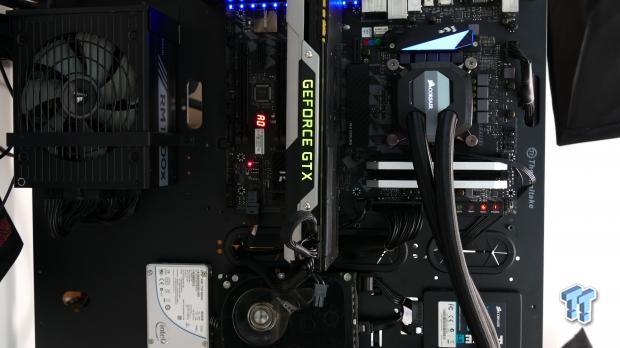
The Z270GT6 has some RGB LEDs, and I am a big one of the RGBs in the VRM heat sink, but not a big fan on the RGBs along the audio section.
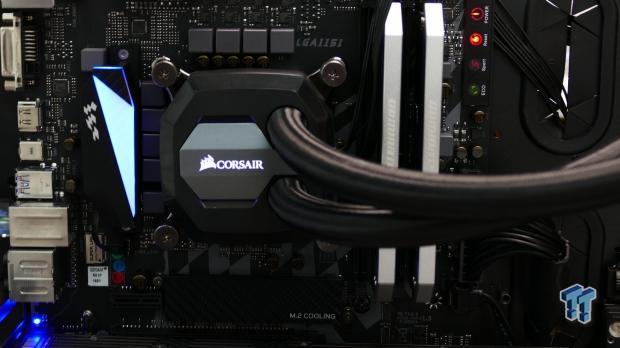
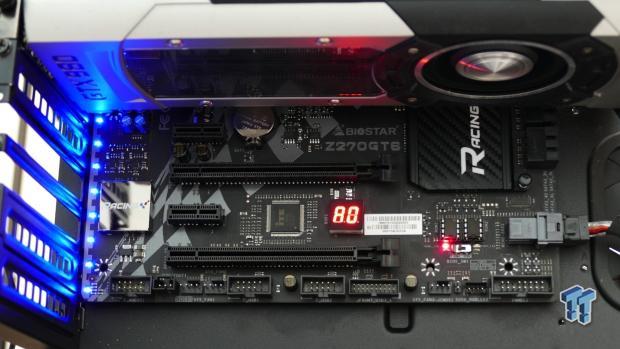
The VRM heat sink's RGB LEDs represent the pinnacle of RGB LED use in heat sinks. The light is well diffused and can change the color of the heat sink. On the other hand, the RGB LEDs in the audio section are the wrong way of using RGB LEDs, at least in my opinion, as they just glare into your eyes.
Overclocking
Overclocking Results
CPU Overclocking
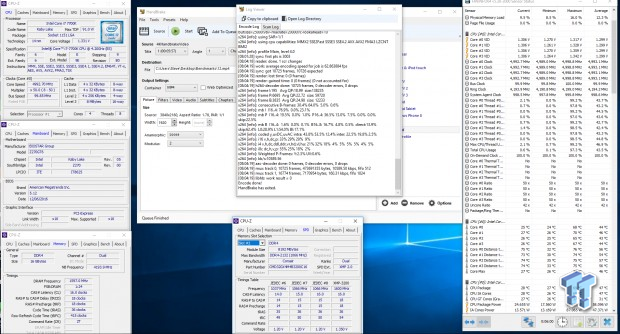
The CPU could reach a 5GHz overclock with 1.3v with XMP enabled, and I was not so much surprised as I was content. The motherboard does have enough of a VRM to pull this off, I was more worried about the memory and LLC parts of the equation, but everything panned out.
Compatible Memory Overclocking Kits
In this section, I overclock four memory kits only using XMP, if the kit works then the results are below. I welcome memory vendors to send in their kits to be tested on each motherboard.
Corsair Dominator Platinum 3200MHz C16 8GBx2
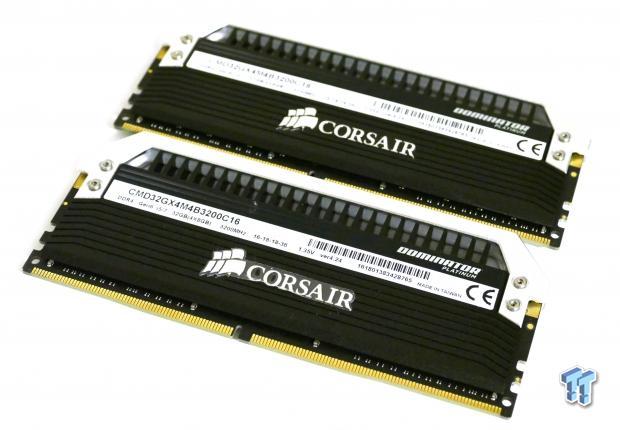
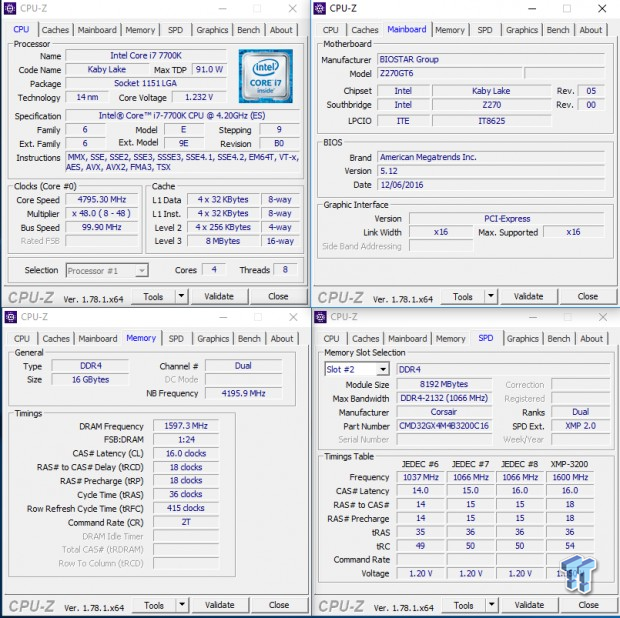
The Z270GT6 doesn't have the best memory overclocking capability. I would definitely use their compatibility list located here.
CPU, Memory, and System Benchmarks
CINEBENCH 11.5
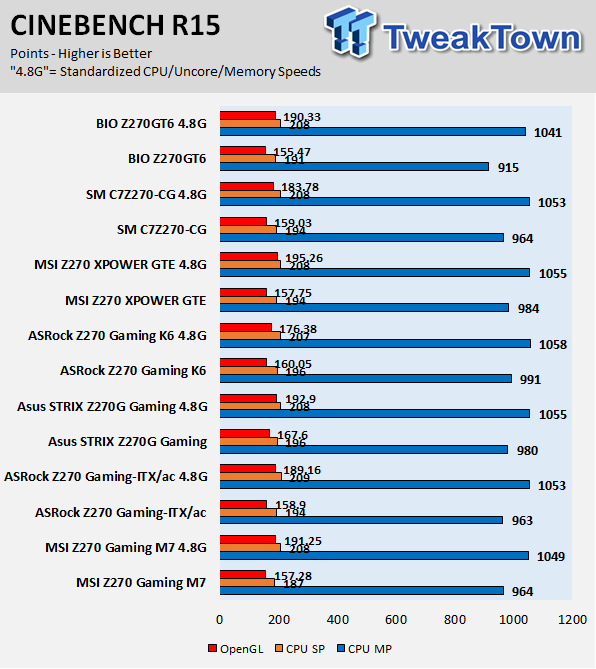
wPrime
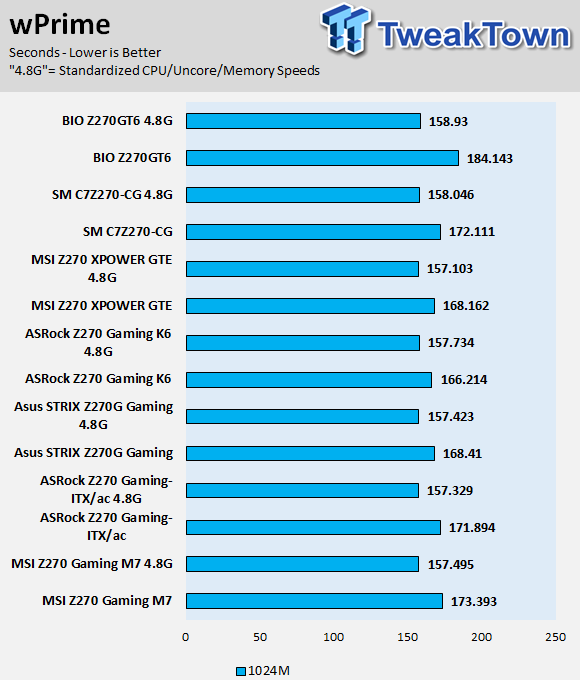
AIDA64 AES and HASH
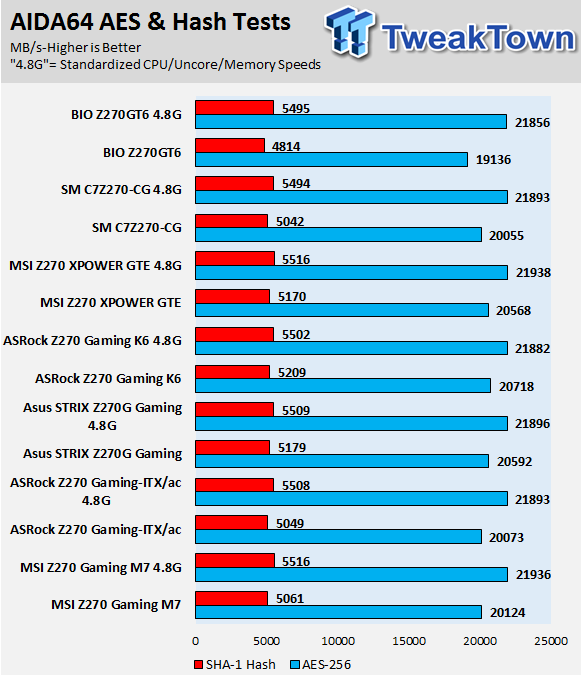
AIDA64 FPU
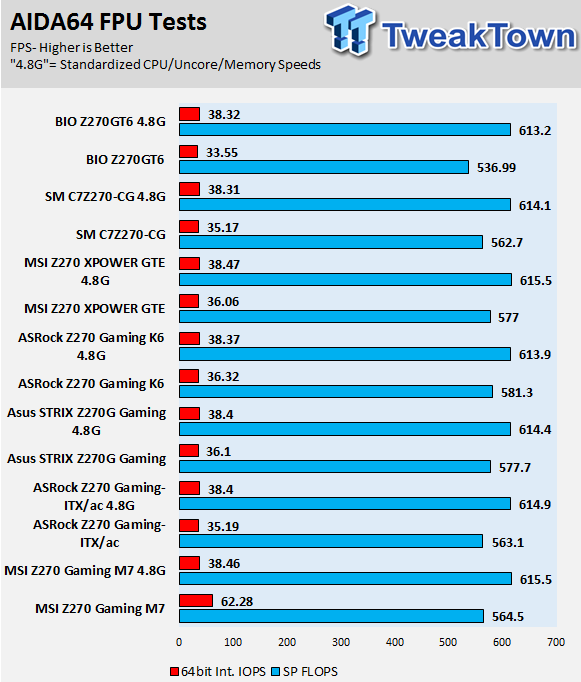
AIDA64 Memory
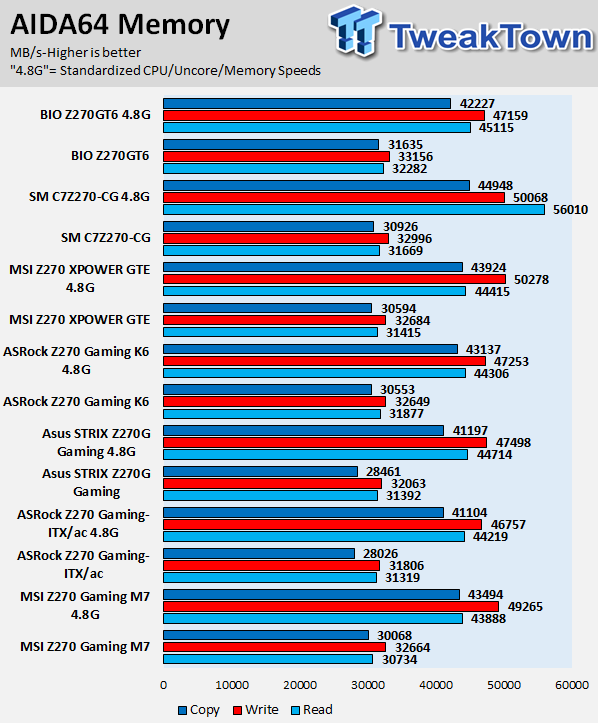
ScienceMark
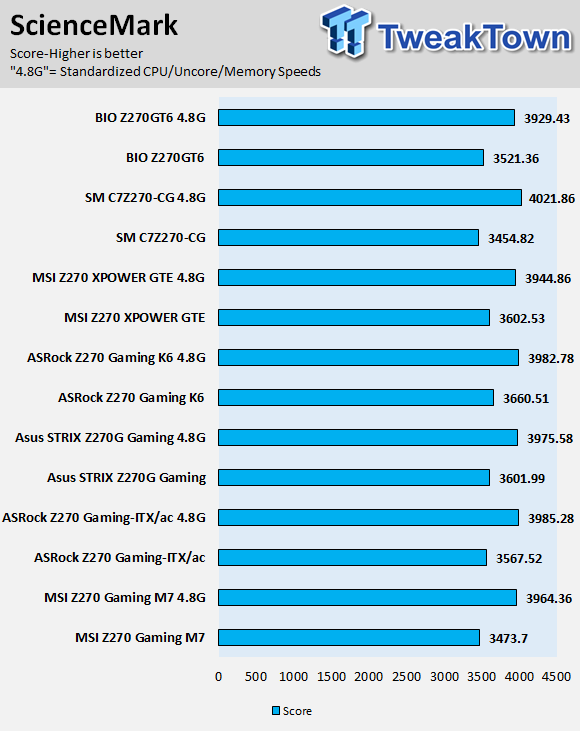
HandBrake
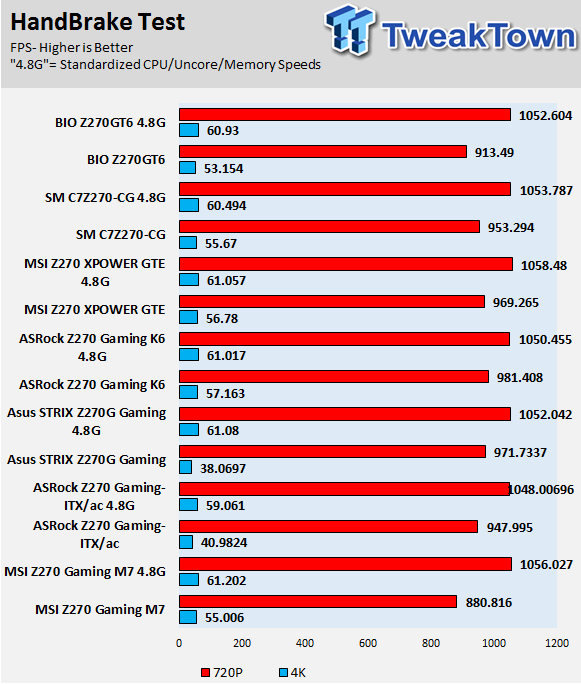
3DMark: Fire Strike
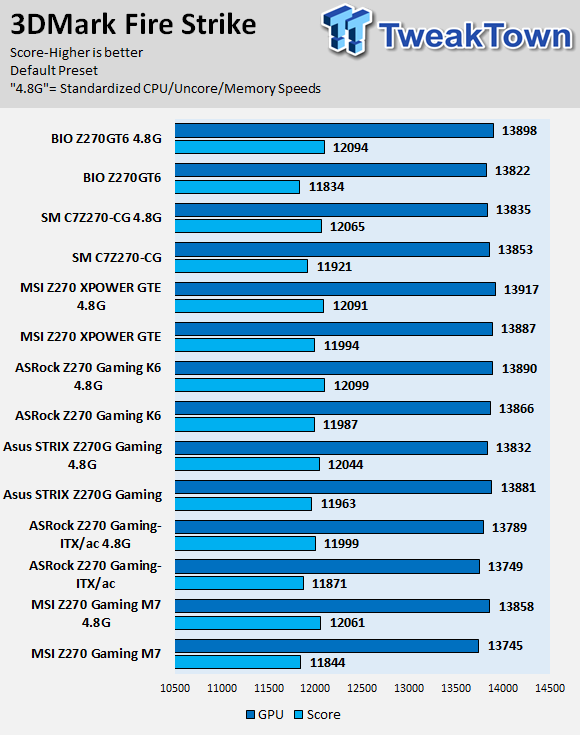
3DMark: Cloud Gate
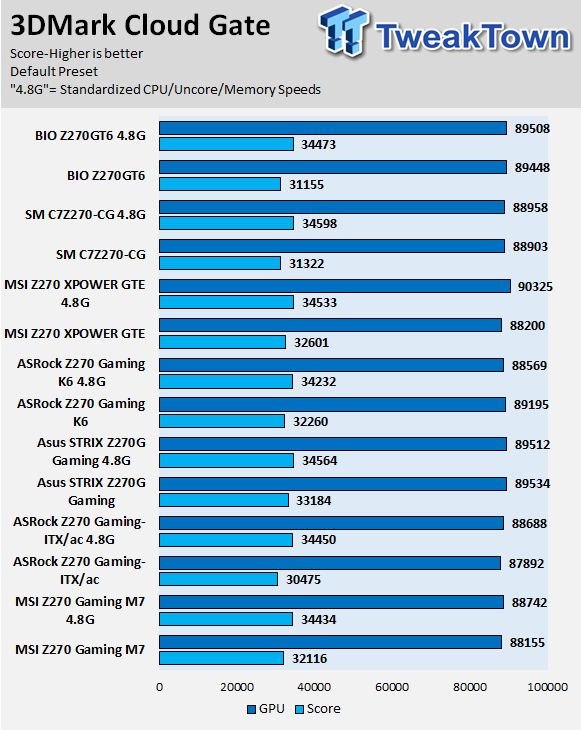
ResidentEvil 6
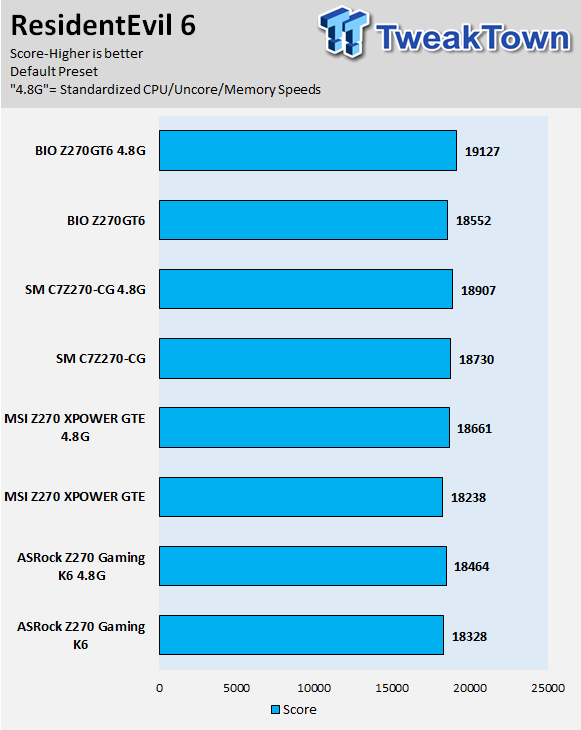
BIOSTAR's multi-core enhancement is not that strong, and when I standardized the settings, it's still not the best performer. The reason is because of the updates for microcode, and the next BIOS update from BIOSTAR (since this one I used is quite old), should bring forth performance improvements.
That being said, is the performance here noticeable? Not at all. In fact, in the only real game benchmarks (Resident Evil 6), it scores better than all the other motherboards, and it keeps up in many of the synthetics.
Some motherboard reviews put a lot of weight into motherboard CPU, memory, and GPU benchmarks, but for me, CPU, memory, and GPU benchmarks on motherboards should be more about finding anomalies, and I do that at standard settings (4.8G in graphs).
System IO Benchmarks
CrystalDiskMark SATA6G:

CrystalDiskMark M.2:
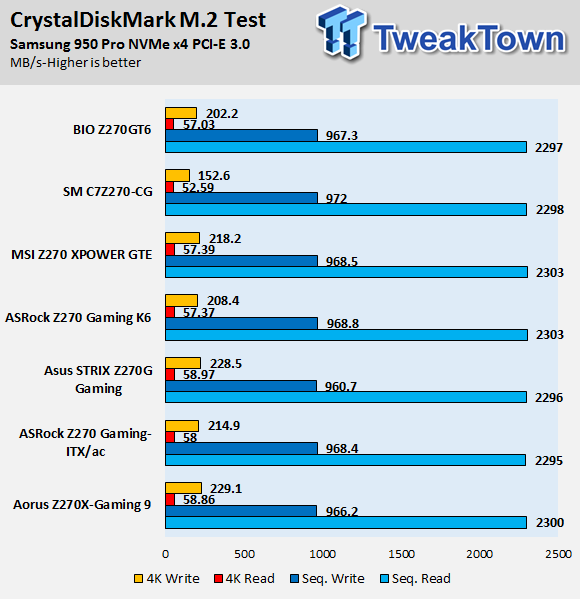
CrystalDiskMark u.2:
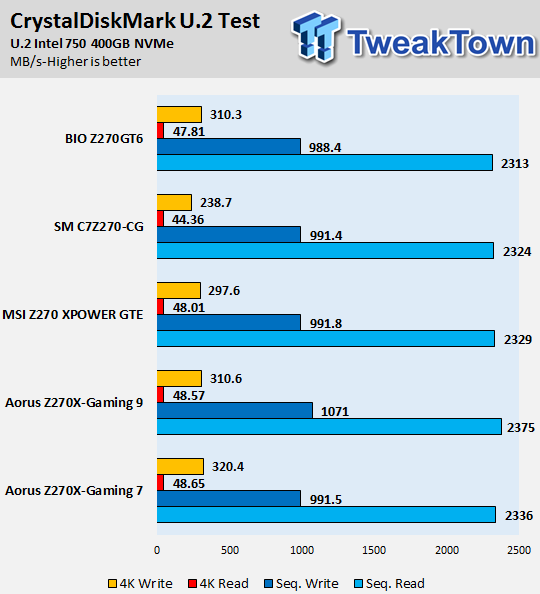
ixChariot Network Throughput:

The Z270GT6's performance in storage benchmark is admirable and keeps up with the big boys.
BIOSTAR does include a 240GB SSD, and that SSD is also quite fast - I benchmarked it in the SATA6G test chart.
Audio RMAA 5.5:
I disable all audio features, set the correct bitrates, and then test the audio with a loopback test.
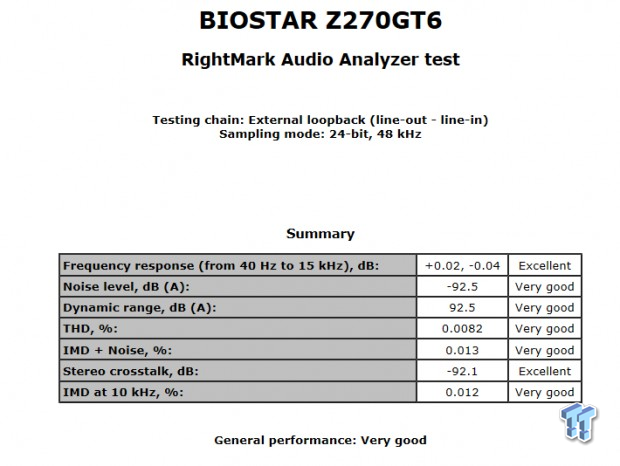
Sound Judgment by Ear: Excellent. BIOSTAR's ALC892 isn't an ALC1150 or ACL1220, but its audio performance is acceptable and is good enough for most people. There are five ratings for audio: 1. Problems, 2. Okay, 3. Acceptable, 4. Very good, 5. Excellent
Thermal Imaging and Power Consumption
System power is measured at the wall with an AC power meter.
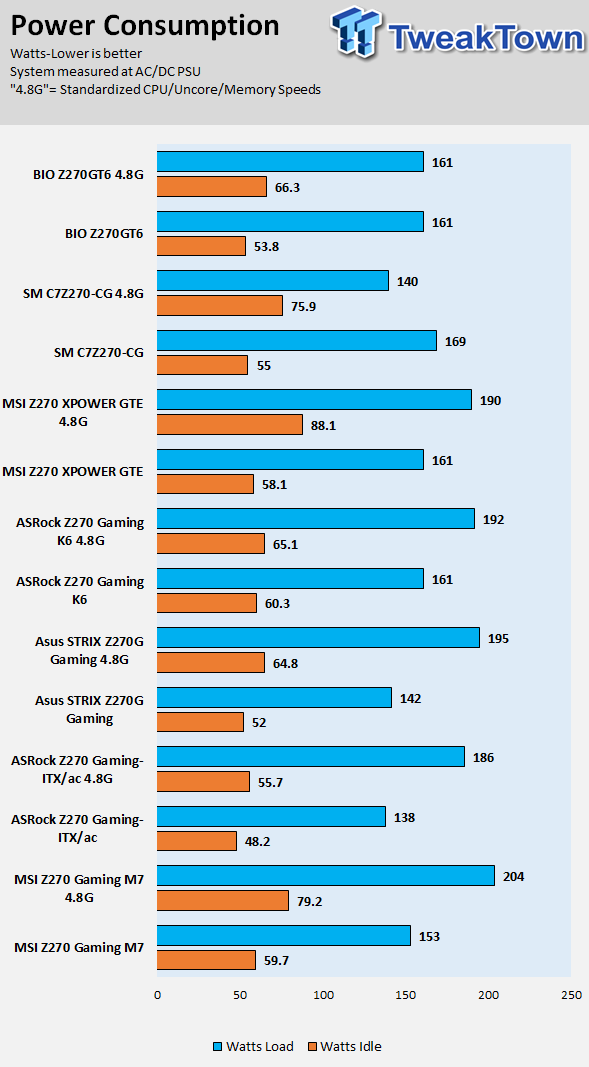
Note on Thermal Images: In the temperature section, we use our Seek thermal imaging camera to capture the surface temperatures of major components on the board. I look at the VRM and then all other things that light up the screen. If there is something to worry about, then I will state it. Otherwise, I will just show the hotter running parts of the board for fun. Unless some component is over 80-90C, then there isn't anything to worry about.
All systems will act differently, so I will look for commonalities, such as how far from the VRM the heat spreads through the PCB and the difference in temperature between the front side and backside of the PCB. Keep in mind, the majority of the heat from the VRM goes into the PCB as it is a giant soldered on copper heat sink. A larger difference in temperature between the back and front of the PCB points towards a more effective heat sink.
Thermal Testing at Stock Speeds:
The image on the left is always at idle, and the image on the right is at load. During ALL TESTS, fans above the VRM that cool the CPU cooler's (Corsair H110i GT) radiator are turned on to high (12v).
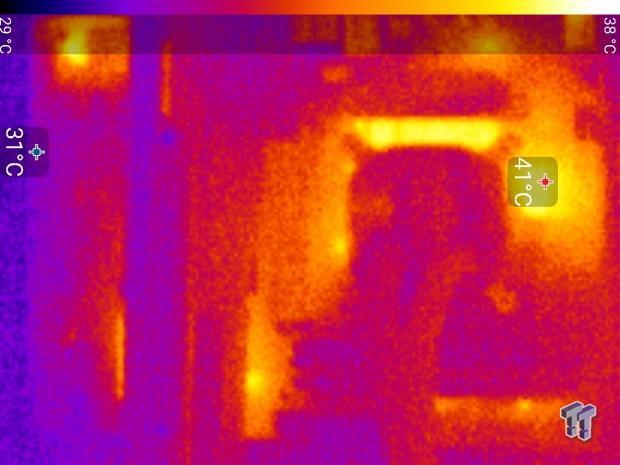
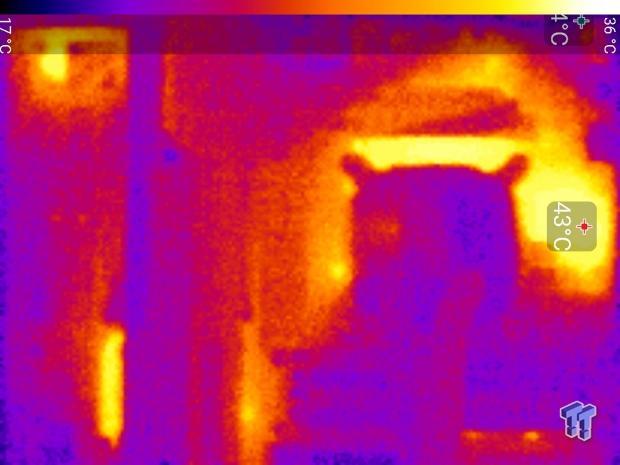
Full frontal.
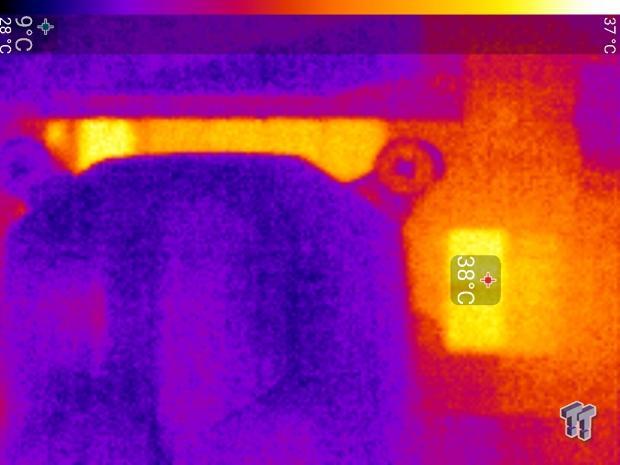

Up-close of the front of the VRM.
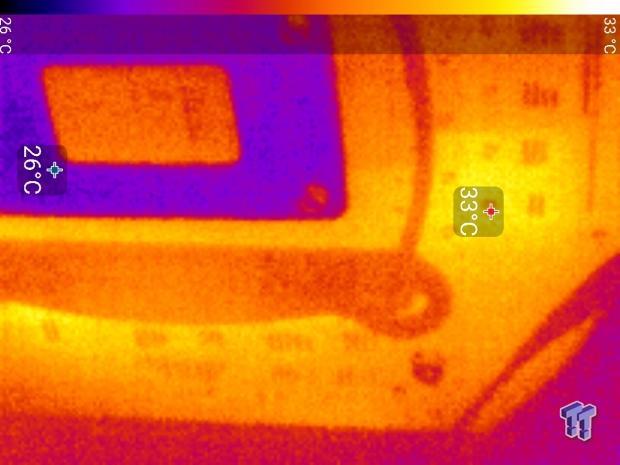
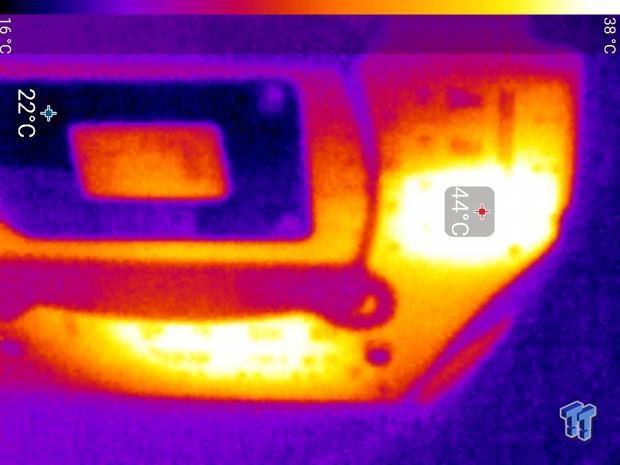
Up-close of the back of the VRM.
Thermal Testing at 4.5GHz Overclocked Speeds:
The image on the left is always at idle, and the image on the right is at load. During ALL TESTS, fans above the VRM that cool the CPU cooler's (Corsair H110i GT) radiator are turned on to high (12v).
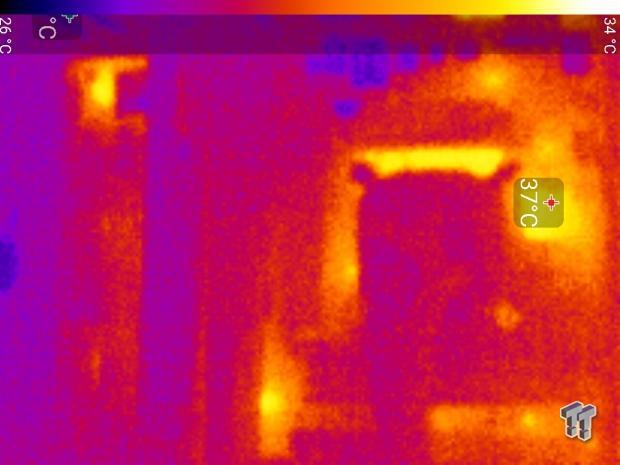
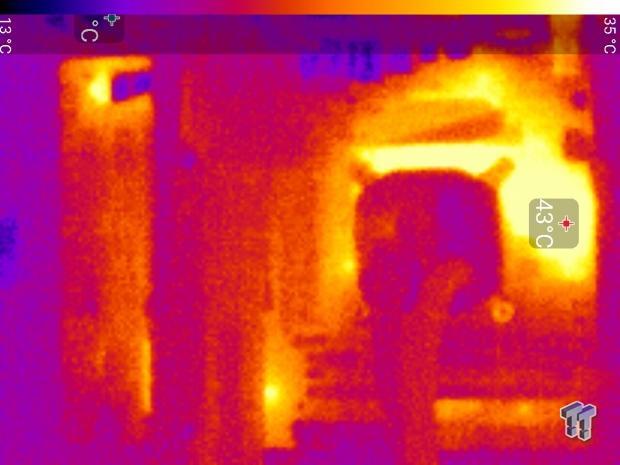
Full frontal.
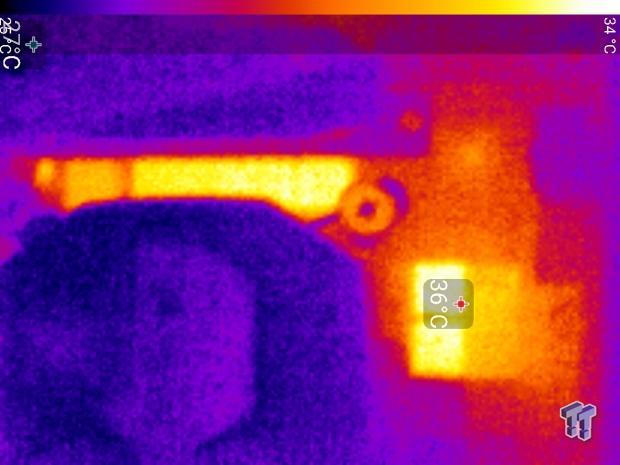
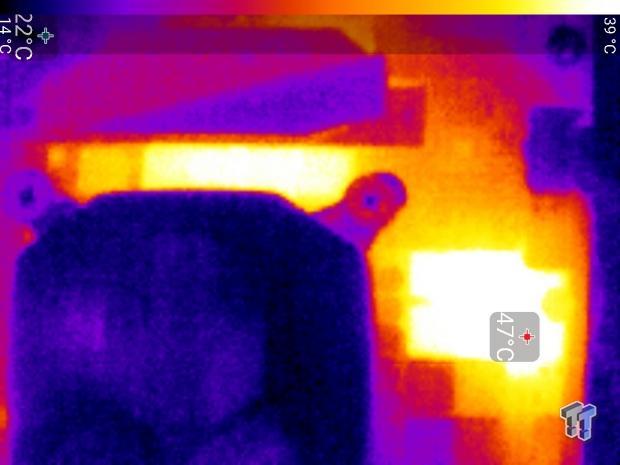
Up-close of the front of the VRM.
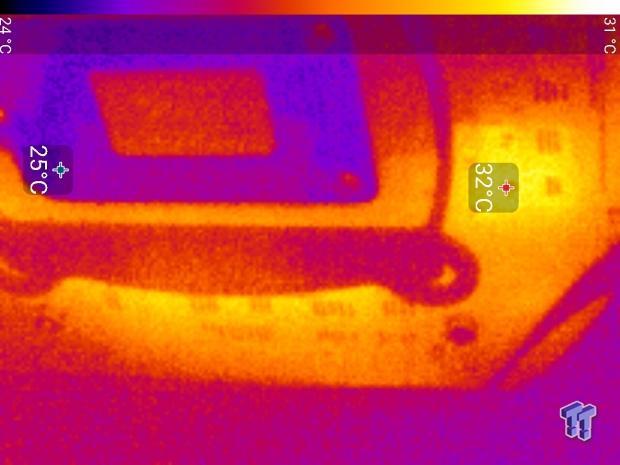
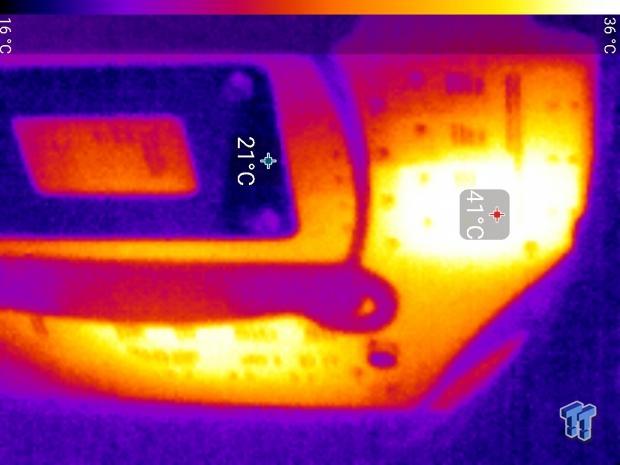
Up-close of the back of the VRM.
The Z270GT6 has a very basic VRM, the most basic I would go with if you plan on any overclocking. Its performance isn't in the danger zone or even the bad zone, it's just average, and BIOSTAR doesn't claim differently.
The really good news is that the VRMs are being cooled quite well even though half of them don't have a heat sink. We see that the temperatures on the rear of the motherboard were never higher than on the front, indicating the heat is being dealt with where it is produced.
Anything under 60C is great, 60-80C is acceptable, and anything above 80C is a bit worrisome (if at stock).
What's Hot, What's Not & Final Thoughts
Here are key points about the BIOSTAR Z270GT6.
What's Hot
Free 240GB SSD: The current price of the Z270GT6 is $189.99, and it comes with a free 240GB SATA6G SSD. The cheapest 240GB SSD I could find on Newegg is $64.99, and if we subtract it from the price of the motherboard we get a $125 motherboard, and the Z270GT6 is an excellent value at that price evaluation. Most people will get an SSD around the 240GB capacity anyways since you would be mad to build a PC these days without one. The included SSD offers good performance too.
M.2, U.2, and Two PCI-E x4 Slots: The Z270GT6 has the latest in storage technologies including M.2, U.2, and two PCI-E x4 slots wired to the PCH and capable of accepting NVMe storage device. Many of the fastest drives these days come in the M.2 or AIC (PCI-E) form factors, and you have many options with the Z270GT6.
Overclocking Features: I didn't expect to find many overclocking features on the Z270GT6, but I did find touch capable power, reset, ECO, and Sport buttons, an LN2 switch (to downclock to 800MHz on-the-fly), a dual BIOS switch, and a POST Code display. The BIOS also has the right settings you will need to overclock the motherboard.
Intel LAN with Protection: BIOSTAR made sure to using Intel's latest LAN controller and provided it with Super LAN, which is an ESD protection surface mount device.
RGB LEDs: The Z270GT6 has not one, but two 5050 RGB LED headers. I am also a huge fan of the RGB implementation in the VRM heat sink. However, I am not a fan of the audio section's RGB implementation, but that doesn't mean you might not like it.
M.2 Heatsink: I have seen some really wimpy M.2 heat sinks come with motherboards, but the one that comes with the Z270GT6 isn't one of them. The heat sink comes with a hefty thermal pad, has one metal layer, then some fins, and another metal layer. It's a real heat sink and not just there for looks.
What's Not
VRM Is Basic: The Z27GT6 has a very basic VRM, perhaps the lowest I would go with if you are going to overclock to 5GHz.
Use the Memory Compatibly List: BIOSTAR has a memory compatibility list on their website, I recommend you use it when selecting memory.
No USB 3.1: While the motherboard does have a type-C USB connector, it's USB 3.0 not USB 3.1.
Final Thoughts
The Z270GT6 with the bundled 240GB SSD is an excellent value product. At the $189 price point, the motherboard isn't that loaded, but if we factor in the price of the SSD or a comparable one, it transforms into really great value. The motherboard does look decent and would be an excellent motherboard for an all-black build that uses RGB LEDs. The white silkscreen easily blends into the background inside a case so that you can choose your own color scheme.
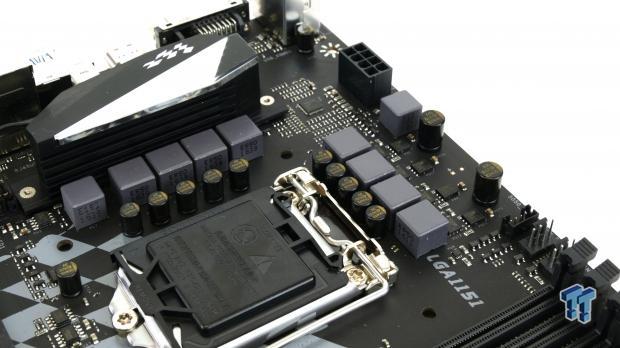
I really love the VRM heat sink's RGB LEDs, the M.2 heat sink, and the fact that the motherboard offers almost every premium feature you might want on a Z270 motherboard. The overclocking features are also a nice touch. I was very surprised to see a POST code display on the motherboard, and the capacitive touch panel is a cool gadget to show friends.
If you want a cool little motherboard and were planning on getting an SATA SSD for your new build, the Z270GT6 is excellent value and is worth a look.

